What Art Movement Would Stan Lee Art Work Be a Part of
A true Marvel: How Stan Lee led the 1960s superhero revolution
The legendary Marvel Comics author Stan Lee has died, aged 95. Without his pioneering work on superhero titles in the 1960s, today'southward cultural landscape would wait very different, with no Fe Man, Spider-Man, Blob, Black Panther or X-Men, writes BRUCE MUNRO.
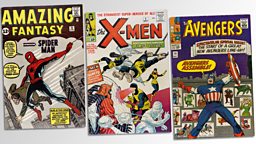
In The Stan Lee Story, Roy Thomas offers his readers Stan Lee'due south own account of the turning indicate of his comic volume career in the early 1960s.
Why don't yous write ane the fashion you want to write it? You lot're going to quit anyway, so if he fires you, who cares?
Lee said: "Well, I had been in the concern for a 1000000 years and I was ready to quit because I didn't similar the stuff we were publishing.
"I didn't similar the stories I was writing because my dominate, the publisher, said to me, 'Stan, just give me a lot of action and a lot of fight scenes, that'south all the readers desire.'
"And I said, 'How most concentrating on story?' 'Forget the story, put a lot of fight scenes on every page.'
"Well, I wanted to get paid, then I did it, but after a while, I got sick of it and I said to my wife, 'I'm going to quit.' And she said to me the wisest words since the Ten Commandments. She said, 'Why don't you write one the manner you desire to write it? You're going to quit anyway, and then if he fires you lot, who cares? Only get information technology out of your organization.' And that's when we did... The Fantastic Four."
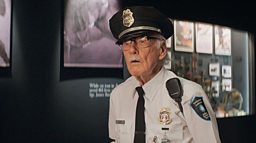
Fantastic Iv
While the diverse Fantastic Four film adaptations have generally been seen as flops, it was a revolutionary comic volume.
To someone who had cut his teeth upon the sanitised niceness of the Justice League of America, this was heady stuff indeed
In a 1983 article, comic volume writer Alan Moore reflected on the impact Lee's characters.
Moore created titles like Watchmen and The League of Extraordinary Gentlemen besides as writing Batman and Superman stories. He reports beingness absorbed as a child by how different the Fantastic 4 characters were in comparing to the clean-living, square-jawed heroes of DC Comics.
He wrote: "The about immediately noticeable thing was the sheer strangeness of Jack Kirby'due south fine art...
"The writing, notwithstanding, was stranger... What was special was the characterisation... the fashion the characters talked, thought and behaved... On more than ane occasion the Matter came dangerously close to actually murdering the Human Torch while in a bad mood and in general you lot had the impression that he was e'er on the verge of turning into a fully fledged villain and quitting the Fantastic Iv for good.
"To someone who had cut his teeth upon the sanitised niceness of the Justice League of America, this was heady stuff indeed. I mean, in DC comics, if Superman ever said anything remotely nasty to Batman or Wonder Woman you lot knew that he was either suffering from the unpredictable furnishings of Red Kryptonite or was having his mind controlled by Lex Luthor's latest 'Brain-Ray'."
The creation of the Fantastic Iv was just the offset of an incredibly fertile creative catamenia for Stan Lee and his almost regular collaborator, Jack Kirby.
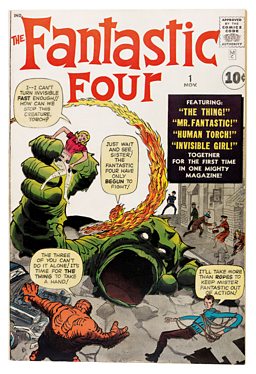
The Blob
Due to the impressive sales figures for Fantastic Iv, Lee and Kirby's publisher Martin Goodman wanted them to create another superhero team. But they had other ideas.
Later on a mere half dozen bug, The Incredible Hulk would really be cancelled
Roy Thomas says that instead they chose to focus on another aspect of the Fantastic Four's entreatment.
He writes: "Since clearly the breakout star of Fantastic Four was the Affair, the new superhero wasn't really another superhero — but rather another sympathetic monster. The Incredible Hulk.
"[But] readers turned out to exist less excited by a monster hero who lacked superheroes to interact with. In fact, after a mere one-half dozen issues, The Incredible Hulk would really be cancelled."
Warning: Third party content may contain adverts.
In 1966 Marvel superheroes broke out onto Goggle box with simplistic cartoons featuring the likes of the Hulk also as Spider-Man, Atomic number 26 Man and Thor.
Spider-Homo
This initially muted reaction to the Hulk didn't slow them downward, though. Thomas writes: "There'southward no way to be sure which new hero series was created third, afterward Fantastic Iv and Blob, since iii new characters would debut that summer [1962] over a period of just a couple of weeks: Thor, Ant-Human, and Spider-Homo. But there's a very adept chance information technology was the wall-crawler.
Y'all tin't call a hero Spider-Human being, Stan. People detest spiders!
"In his youth, Stanley Martin Lieber [Lee'south real proper name] had loved the masked hero of a pulp magazine chosen The Spider. At that place hadn't actually been anything spiderlike about him besides his name, but Stanley had loved that proper noun. But when Stan Lee told his boss his Spider-Human being idea, Goodman loathed everything about it!
"The name? 'You tin can't call a hero Spider-Man, Stan. People hate spiders!' The concept? 'He's a teenager? Teenagers can only be sidekicks!' The 'personal problems' Stan wanted him to have? 'Heroes are as well busy fighting evil to ho-hum down the stories with personal stuff.'"
Despite all of Goodman's reservations, Lee got to publish a Spider-Homo story in an edition of Amazing Adult Fantasy. The character was designed past Steve Ditko rather than Jack Kirby.
Ditko said of his pattern: "One of the first things I did was to work upwardly a costume. A vital, visual office of the character. I had to know how he looked earlier I did any breakdowns. For case: A clinging power so he wouldn't have difficult shoes or boots, a hidden wrist-shooter versus a web gun and holster, etc... I wasn't certain Stan would similar the idea of covering the graphic symbol's face only I did it because it hid an manifestly adolescent face. It would also add together mystery to the grapheme."
When sales reports for Spider-Man'south debut in Amazing Fantasy No fifteen, publisher Martin Goodman declared it a "smash success" and suggested to Lee that the character be given his own serial.
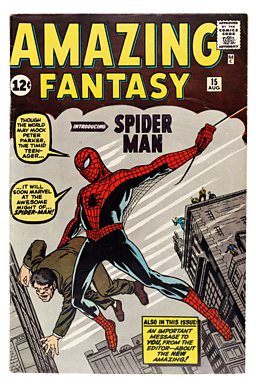
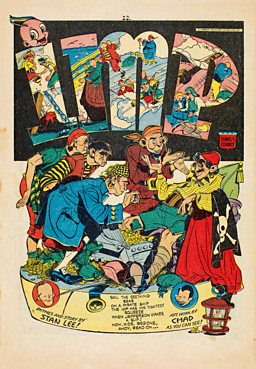
Iron Human being
The initial appearance of Iron Man, in Tales of Suspense, in which he fought against North Vietnamese forces was, in some ways, standard comic book fare according to Roy Thomas.
I idea it would exist fun to take the kind of grapheme that nobody would similar and shove him down their throats
He writes: "That tale was a natural successor to the superhero-versus-Axis yarns that he and other Timely writers had scribed during Globe War II, simply with Communists replacing the Nazis and Japanese."
But the man inside the suit, Tony Stark, was a deviation from the norm. According to Lee, the character was a deliberate challenge he set himself.
Lee said: "Information technology was the height of the Common cold War. The readers, the young readers, if there was one affair they hated, it was war, it was the military. Then I got a hero who represented that to the hundredth degree.
"He was a weapons manufacturer, he was providing weapons for the Ground forces, he was rich, he was an industrialist. I thought information technology would be fun to take the kind of graphic symbol that nobody would like, none of our readers would similar, and shove him down their throats and make them similar him."

X-Men and The Avengers
Martin Goodman, publisher of Marvel comics, continually pushed Lee to copy successful formats. Thomas writes: "With both Fantastic 4 and Spider-Human being selling, Martin Goodman wanted a virtual clone of each. That'southward right — two additional superhero titles, to debut in the summer of '63 — i featuring a group of heroes, the other, a solo stalwart. And Stan, way past all thoughts of leaving either the visitor or the comicbook industry by this bespeak, was happy to oblige.
Sensing that 'Cap' was a natural leader, Stan made him a linchpin of the grouping most at once
"The group title came easiest. Rather than having its heroes acquire superpowers via cosmic rays, gamma rays, a radioactive spider, any — what if they were born with them?"
Lee over again collaborated with Jack Kirby to create the original X-Men crew – Cyclops, Marvel Girl, the Beast, Iceman, and the Angel, led past Professor Ten – who were pitted against the evil mutant Magneto.
But when the production of the unmarried superhero story, Daredevil, was delayed (the illustrator struggled to fit it in around his day job at Hallmark Cards) Lee brought together some of his existing characters – Thor, Fe Homo, the Blob, Ant-Homo and the Wasp – in a team he called The Avengers.
Thomas writes: "Stan would make major changes to The Avengers, from effect to issue, as befitted a series cobbled together to meet an 11th-hour emergency... by Avengers No 3, Fe Man would sport new, streamlined, red-and-yellow armour... and in the landmark fourth issue, at the turn of '64, he brought back the 3rd of Timely'south Golden Age Large Three heroes.
"Captain America, it was discovered, had been frozen in suspended animation inside an iceberg since well-nigh the terminate of the Second Globe State of war. Sensing that 'Cap' was a natural leader, Stan fabricated him a linchpin of the group almost at once."

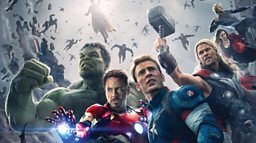
Black Panther
Lee also innovated in terms of race, introducing Black Panther, a stereotype-gratuitous black superhero who start appeared in a Fantastic Four story in 1966, only two years after the finish of public segregation.
It was a strange coincidence considering at the time I did The Black Panther, there was a political political party and they were called the Black Panthers.
He said: "He doesn't alive in a regular tribe and so forth; he is the prince of a nation, and the nation is hidden under the basis. It's a country called Wakanda, and he is one of the greatest scientists in the world; and his surface area, his country is more scientifically advanced than any."
Despite the proper noun, the character was not meant to be explicitly political.
Lee remarked: "Information technology was a strange coincidence because at the time I did The Black Panther, in that location was a political party in the country - mostly black people - and they were called the Blackness Panthers. And I didn't think of that at all! It had nothing to do with our character, although a lot of people thought there was some tie-in.
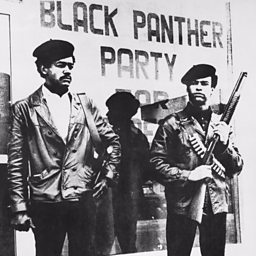
Lee's legacy
Stan Lee's legacy stretches beyond the characters he created. While Alan Moore criticised the quality of Lee's later piece of work, he argued that the writers who came behind Lee were in his debt.
The Marvel method gets a bad rap in the comics customs these days considering it allowed Lee to merits he'd written stories that were actually co-plotted by the artists
He wrote: "If I wore a lid information technology would certainly be doffed to Mr Lee for providing me with the inspiration that is currently helping to pay my rent."
Some claim that Lee has received more credit than he deserves for the creation of Marvel characters.
Much of this is due to the way that Lee kept up with high volume of content for the many Marvel titles that were published every month. In his all-encompassing 2016 Vulture piece on Lee'south legacy, Abraham Riesman outlined the touch on of 'the Marvel method'.
He wrote: "To save fourth dimension while writing a dozen or more than comics at in one case, Lee had recently developed a thrifty alternative to writing out full scripts. He'd only come up with a rough plot — 'as much every bit I tin write in longhand on the side of i sheet of paper,' as he put it in a 1968 interview — talk that over with the artist, then brand the creative person get off and create the entire story from scratch."
Just Riesman points out that this approach also had the issue of encouraging creativity.
He says: "The Marvel method gets a bad rap in the comics community these days because it immune Lee to merits he'd written stories that were actually co-plotted by the artists, only at the time, it was an artistically fertile game-changer. The tyranny of total scripts was over, and artists were free to come up upward with graphic ideas that worked for them."

0 Response to "What Art Movement Would Stan Lee Art Work Be a Part of"
Post a Comment